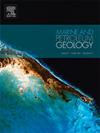Methanogenetic evolution of a buried pinnacle structure overlying a fluid-escape pipe in the Western Exmouth Plateau, Australia
IF 3.6
2区 地球科学
Q1 GEOSCIENCES, MULTIDISCIPLINARY
引用次数: 0
Abstract
The formation and evolution of carbonate pinnacles in sedimentary basins remain a subject of significant scientific interest, particularly in relation to their interaction with subsurface fluid migration. This study uses high-resolution three-dimensional (3D) seismic reflection data to investigate an isolated and buried carbonate pinnacle (∼700 m wide and 99 m high) in the Exmouth Plateau, offshore Australia. The pinnacle shows a cone-shaped morphology with internally admixed low- to moderate-amplitude seismic reflections and is spatially associated with an underlying vertical zone of low-amplitude and chaotic reflections, interpreted as a fluid-escape pipe. The presence of this pipe suggests focused vertical fluid migration from a potential deep-seated source, likely the early Triassic Locker Shale. Seismic onlap of overlying sediments on the pinnacle flanks precludes its interpretation as a seismic artifact, supporting its in situ origin. The observed structural and stratigraphic relationships indicate that episodic methane expulsion influenced pinnacle development, suggesting a methanogenetic origin. These findings provide added insights into the role of fluid migration in carbonate system evolution and have broader implications for understanding reservoir formation, diagenetic alteration, and subsurface fluid storage. Importantly, our study advances the geoscientific understanding of carbonate diagenesis and basin evolution in both modern and ancient settings by elucidating the interaction between fluid escape features and carbonate build-ups.
澳大利亚西埃克斯茅斯高原流体逸出管道上埋顶构造的甲烷成因演化
沉积盆地中碳酸盐岩尖塔的形成和演化仍然是一个重要的科学研究课题,特别是与地下流体运移的相互作用。这项研究使用高分辨率三维(3D)地震反射数据来研究澳大利亚近海Exmouth高原上一个孤立和埋藏的碳酸盐岩尖顶(约700米宽,99米高)。尖顶呈锥形形态,内部混合低至中振幅地震反射,在空间上与底层低振幅和混沌反射的垂直区域相关联,被解释为流体逃逸管道。这条管道的存在表明,流体从潜在的深层来源(可能是早三叠纪储层页岩)集中垂直运移。峰顶两侧上覆沉积物的地震叠加排除了其作为地震人工制品的解释,支持其原位起源。观察到的构造和地层关系表明,幕式甲烷排出影响了塔尖的发育,表明甲烷成因。这些发现为流体运移在碳酸盐岩系统演化中的作用提供了新的见解,并对理解储层形成、成岩蚀变和地下流体储存具有更广泛的意义。重要的是,我们的研究通过阐明流体逸出特征与碳酸盐堆积之间的相互作用,促进了对现代和古代碳酸盐成岩作用和盆地演化的地球科学认识。
本文章由计算机程序翻译,如有差异,请以英文原文为准。
求助全文
约1分钟内获得全文
求助全文
来源期刊

Marine and Petroleum Geology
地学-地球科学综合
CiteScore
8.80
自引率
14.30%
发文量
475
审稿时长
63 days
期刊介绍:
Marine and Petroleum Geology is the pre-eminent international forum for the exchange of multidisciplinary concepts, interpretations and techniques for all concerned with marine and petroleum geology in industry, government and academia. Rapid bimonthly publication allows early communications of papers or short communications to the geoscience community.
Marine and Petroleum Geology is essential reading for geologists, geophysicists and explorationists in industry, government and academia working in the following areas: marine geology; basin analysis and evaluation; organic geochemistry; reserve/resource estimation; seismic stratigraphy; thermal models of basic evolution; sedimentary geology; continental margins; geophysical interpretation; structural geology/tectonics; formation evaluation techniques; well logging.
 求助内容:
求助内容: 应助结果提醒方式:
应助结果提醒方式:


